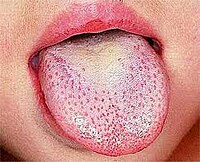
Photo from wikipedia
Bevacizumab-induced rash is a rarely reported complication with very few insights into its epidemiology, pathophysiology, management and relationship with therapeutic efficacy. We report a case of ruptured occipital arteriovenous malformation… Click to show full abstract
Bevacizumab-induced rash is a rarely reported complication with very few insights into its epidemiology, pathophysiology, management and relationship with therapeutic efficacy. We report a case of ruptured occipital arteriovenous malformation treated with stereotactic radiosurgery. The patient developed steroid-resistant radiosurgery-induced brain oedema. Oedema partially responded to bevacizumab, and the patient tolerated the treatment well except for skin rash. He developed multiple discrete monomorphic papulopustular lesions with intervening hyperpigmented macules after bevacizumab intravenous infusion. The patient was further treated with benzoyl peroxide gel for local application and oral doxycycline. The rash reappeared whenever bevacizumab was reintroduced to the regimen beyond 7.5 mg/kg body weight at 3 weekly intervals. After dose modification to 5 mg/kg body weight, 6 cycles were administered with no further rash and resolution of oedema. There is no need to halt bevacizumab therapy, although it can be continued at a lesser dose as it may be a dose-dependent complication.
Journal Title: BMJ Case Reports
Year Published: 2022
Link to full text (if available)
Share on Social Media: Sign Up to like & get
recommendations!